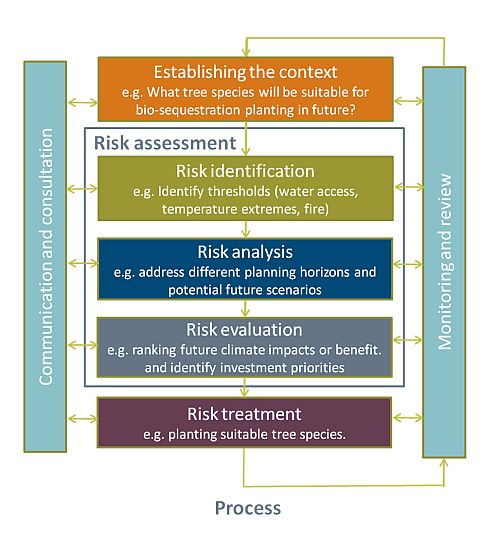Climate Change in Australia
Climate information, projections, tools and data
Conducting an impact assessment
Climate change information and data provide an essential input to the impact assessment process. Methods for generating, presenting and selecting data are described in this website, along with information to help users find data and research tools.
Climate information is required as an input into climate change risk assessment at the following stages:
Establishment of the context of the impact assessment by defining the scope, the stakeholders (and their concerns), and other issues or required decisions.
Identification of the known risks associated with current climate variability, noting that variables driving current climate risk are also likely to be important under future climate change.

Impact assessment flow chart SOURCE: CCIA Technical Report, 2015
Current risks are affected by current climate variability, especially extreme events. For example, railway lines are sensitive to buckling on extremely hot days, while the timing of grape maturity can be sensitive to growing season temperature and soil moisture status, and urban flooding may be influenced by extreme daily rainfall. Small changes in average climate underpin larger changes in extreme weather phenomena such as heatwaves, frost, flood, cyclones, storm surges, tornadoes and hail. Combinations of variables are required to quantify risk factors such as fire weather (temperature, humidity, wind and rain), snow cover (precipitation and temperature) and soil moisture (rainfall and evaporation).
In an impact assessment, it is important to understand the relevant temporal scales. For some studies, it is necessary to assess hourly climate data, while for others monthly or seasonal averages can be sufficient. In many situations it is the intensity, frequency and/or duration of a weather event that can significantly affect risk. In other cases, it is the sequence of events that is important, such as consecutive or clustered occurrences, or coincident events involving two or more climate variables.
The spatial scale required in an impact assessment will vary depending on the proposed project outcome. For example, a study on pome fruit used data from a single location in the relevant horticultural regions to describe reductions in accumulated annual chilling (exposure to cold temperatures required to break dormancy) in future climates, whereas catchment scale information is often required in hydrological studies. Local government area (LGA) climate data can also be useful to align with other inputs such as population data. Sometimes, even broader-scale data are sufficient for national assessments.
Risk analysis includes a review of current management regimes and an analysis of the new levels of risk for different climate scenarios.
Planning horizons: Changes in intensity, frequency, duration and timing are relevant across a range of temporal and spatial scales. Decisions made today will have consequences for many decades in future with regard to regional planning, land use, infrastructure investments, etc. The planning horizon will vary for different sectors. For example, when planning forest plantings for bio-sequestration of carbon emissions, the trees will be exposed to the climate in 2030 and beyond, so it is important to consider climate change projections.
Data sources: Climate change projection data are usually based on output from climate models driven by various scenarios of greenhouse gas and aerosol emissions (see Chapters 3, 7 and 8 Technical Report). Data can be accessed via a range of providers, such as national weather services, government departments, non-governmental organisations, academic institutions or research organisations. Identifying an appropriate dataset for use in impact assessment requires a good understanding of the pros and cons of different methods and data products.
After the risk assessment is carried out, risk treatment decisions can be made (see the impacts and adaptation section), with emphasis on continuous monitoring of their effectiveness, and reviewing the lessons learnt in a dynamic and iterative process.
------------
Page updated 24th December 2020



